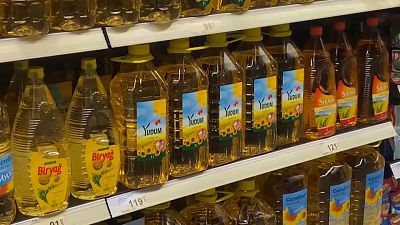Turkey
For months, Istanbul restaurant Tarihi Balikca tried to absorb the surging cost of the sunflower oil it uses to fry fish, calamari and mussels.
But in early April, with oil prices nearly four times higher than they were in 2019, the restaurant finally raised its prices.
Now, even some longtime customers look at the menu and walk away.
"We resisted. We said, 'Let's wait a bit, maybe the market will improve, maybe (prices) will stabilize. But we saw that there is no improvement," said Mahsun Aktas, a waiter and cook at the restaurant. "The customer cannot afford it."
Global cooking oil prices have been rising since the COVID-19 pandemic began for multiple reasons, from poor harvests in South America to virus-related labor shortages and steadily increasing demand from the biofuel industry.
The war in Ukraine — which supplies nearly half of the world's sunflower oil, on top of the 25% from Russia — has interrupted shipments and sent cooking oil prices spiraling.
It is the latest fallout to the global food supply from Russia's war, and another rising cost pinching households and businesses as inflation soars.
The conflict has further fueled already high food and energy costs, hitting the poorest people hardest.
The food supply is particularly at risk as the war has disrupted crucial grain shipments from Ukraine and Russia and worsened a global fertilizer crunch that will mean costlier, less abundant food.
The loss of affordable supplies of wheat, barley and other grains raises the prospect of food shortages and political instability in Middle Eastern, African and some Asian countries where millions rely on subsidized bread and cheap noodles.
Vegetable oil prices hit a record high in February, then increased another 23% in March, according to the U.N. Food and Agriculture Organization.
Soybean oil, which sold for $765 per metric ton in 2019, was averaging $1,957 per metric ton in March, the World Bank said.
Palm oil prices were up 200% and are set to go even higher after Indonesia, one of the world's top producers, banned exports last week to protect domestic supply.
Some supermarket chains in Turkey have imposed limits on the amount of vegetable oil households can purchase after concerns about shortages sparked panic-buying.
German shoppers are posting photos on social media of empty shelves where sunflower and canola oil usually sit.
Spain, Italy and the United Kingdom are rationing.
Emiwati, who runs a food stall in Jakarta, Indonesia, said she needs 24 liters of cooking oil each day.
She makes nasi kapau, traditional mixed rice that she serves with dishes like deep-fried omelettes.
Since January, she's had trouble ensuring that supply, and what she does buy is much more expensive.
Profits are down, but she fears losing customers if she raises prices.
"I am sad," said Emiwati, who only uses one name.
"We accept the price of cooking oil increasing, but we cannot increase the price of the foods we sell."
Prices could moderate by this fall, when farmers in the Northern Hemisphere harvest corn, soybeans and other crops, according to industry experts.
But there's always the danger of bad weather.
Last year, drought pummeled Canada's canola crop and Brazil's soybean crop, while heavy rains affected palm oil production in Malaysia.
Farmers may be hesitant to plant enough crops to make up for shortfalls from Ukraine or Russia because they don't know when the war might end, said Steve Matthews, co-head of research at Gro Intelligence, an agriculture data and analytics company.
"It's possible that they (prices) have plateaued in the short run however the fundamentals are still extremely bullish for prices. And the reason for that is not necessarily, or not entirely, the Ukraine war but rather, the already existing shortage and price increase in fertilizers globally," said Mathews.
"That ultimately, largely, comes down to the energy, the availability of natural gas in particular has caused massive increases in prices of fertilizer, which will lead to farmers using less fertilizer this year, which will lead to smaller crops, which will lead to higher prices in the long run," he continued.
Longer term, the crisis may lead countries to reconsider biofuel mandates, which dictate the amount of vegetable oils that must be blended with fuel in a bid to reduce emissions and energy imports.
Indonesia recently delayed a plan to require 40% palm oil-based biodiesel, while the European Commission said it would support member states that choose to reduce their biofuel mandates.
In the meantime, consumers and businesses are struggling.
Harry Niazi, who owns Famous Olley's Fish Experience in London, says he used to pay around 22 pounds ($29) for a 20-litre jug of sunflower oil; the cost recently jumped to 42.50 pounds ($55).
Niazi goes through as many as eight jugs per week.
But what worries him even more than rising prices is the thought of running out of sunflower oil altogether.
He's thinking of selling his truck and using the cash to stock up on oil to ensure his business can continue to operate.
"It's very, very scary, and I don't know how the fish and chips industry is going to cope," he said.














Go to video
Libya devalues currency for first time in four years amid fiscal strain
Go to video
Africa advances toward financial integration with new currency exchange marketplace{Business Africa}
03:06
Nigeriens frustrated by ongoing fuel shortage
Go to video
Muslims in Cairo stock up on provisions for Ramadan
01:49
January sees Egypt's inflation Fall to 23.0% due to base effect
01:32
UN Security Council meeting highlights South Sudan's economic hurdles